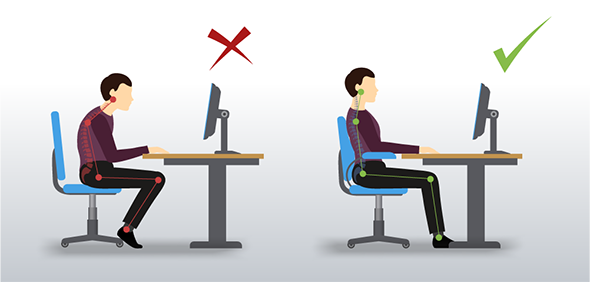
By
Rob Boyle
October 10, 2024
Updated
October 10, 2024

What is ergonomic safety and why is it important
Ergonomics looks at your work environment and how your body is affected by the positions and situations you are put in. Many jobs require sitting for extended periods of time or heavy lifting, all of which require ergonomic safety.
Believe it or not, ergonomics can make your job easier and keep you safer. Musculoskeletal disorders develop because of repetitive stress and strain to the body system. This occurs most often at the desk as sitting in front of the computer and concentrating on computer tasks for extended periods of time can be damaging to the body if it is not allowed to rest in a proper configuration during these tasks.
How can I make my work space more ergonomic?
We spend a considerable time sitting and chairs greatly influence our posture. Remember these techniques to help escape injury:
- Try to take regular breaks. Get up and stretch or walk around the office to get your blood flowing.
- Don't be a slouch! Sit up comfortably in a chair that supports your lower back. Slouching puts more pressure on your back. Use the lumbar support of your chair and avoid sitting in a way that places body weight more on one side than on the other. Move your chair as close to your work as possible to avoid leaning and reaching. Make sure you pull in your chair every time you sit down.
- Adjust your chair. Your feet should not be dangling when you are seated. If your feet don't comfortably reach the floor, there is pressure on the backs of your legs. Use a footrest or lower the keyboard and chair.

- Position your equipment. Your monitor should be placed directly in front of you, with the top no higher than eye level. The keyboard should be directly in front of the monitor, so you don't have to frequently turn your head and neck. The keyboard and mouse should be close enough to prevent excessive reaching, which strains the shoulders and arms.
- Adjust your head. Watch your head position and try to keep the weight of your head directly above its base of support (neck). Don't "crane" your head and neck forward.
 Check your arms. During computer work, ensure that you adjust your chair height so that your forearms are comfortably resting on the desk and your elbows are roughly at right angles. Make sure the weight of your arms is supported at all times. If your arms are not supported, the muscles of your neck and shoulders will be sore by the end of the day.
Check your arms. During computer work, ensure that you adjust your chair height so that your forearms are comfortably resting on the desk and your elbows are roughly at right angles. Make sure the weight of your arms is supported at all times. If your arms are not supported, the muscles of your neck and shoulders will be sore by the end of the day.- Avoid eye strain. You should rest your eyes periodically or several seconds by looking at objects at a distance to give your eyes a break. Make sure your monitor is not too close. It should be at least an arm's length away. Take steps to control screen glare, and make sure that the monitor is not placed in front of a window or a bright background.

- Vary your tasks. Alternate your tasks, so that you are trying to avoid the same movements for prolonged periods using the same part(s) of your body.
- Co-operate with arrangements your employer introduces to reduce risks. This may be through systems or equipment in place for you to use or a system of reporting accidents, near misses or symptoms of ill health.
- Get proper tools. Talking on the phone with the phone receiver jammed between the neck and ear is a bad practice. Ask about using a headset if you frequently have long calls.
How can I be ergonomically safe if using industrial tools?
- Maintain straight wrists. Avoid unnatural bending or rotating wrists.
- Look out for bent-handle tools.
- Your tools should have a compressible gripping coating over its handles.
- If you use a particular tool a lot, you will tend to be engaged in repetitive trigger finger actions. If so, try to mix up your tasks to prevent static muscles injury.
- Wear gloves that fit. Loose grip reduces grip strength and pose other safety hazards. Tight fitting gloves are uncomfortable and add pressure.
